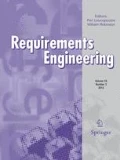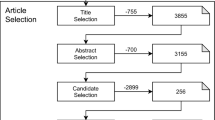Abstract
The paper presents a framework for the empirical evaluation of conceptual modeling techniques used in requirements engineering. The framework is based on the notion that modeling techniques should be compared via their underlying grammars. The framework identifies two types of dimensions in empirical comparisons—affecting and affected dimensions. The affecting dimensions provide guidance for task definition, independent variables and controls, while the affected dimensions define the possible mediating variables and dependent variables. In particular, the framework addresses the dependence between the modeling task—model creation and model interpretation—and the performance measures of the modeling grammar. The utility of the framework is demonstrated by using it to categorize existing work on evaluating modeling techniques. The paper also discusses theoretical foundations that can guide hypothesis generation and measurement of variables. Finally, the paper addresses possible levels for categorical variables and ways to measure interval variables, especially the grammar performance measures.



Similar content being viewed by others
References
Avison DE, Fitzgerald G (1995) Information systems development: methodologies, techniques, and tools, 2nd edn. McGraw-Hill, London
Agarwal R, Sinha A, Tanniru M (1996) Cognitive fit in requirements engineering: a study of object and process models. J Manag Inf Syst 13(2):137–162
Agarwal R, De P, Sinha AP (1999) Comprehending object and process models: an empirical study. IEEE Trans Softw Eng 25(4):541–556
Batra D, J Hoffer, R Bostrom (1990) Comparing representations with relational and EER models. Commun ACM 33(2):126–139
Bodart F, Sim M, Patel A, Weber R (2001) Should optional properties be used in conceptual modelling? A theory and three empirical tests. Inf Syst Res 12(4):384–405
Brooks FP (1998) The mythical man-month: essays of software engineering, Anniversary edition. Addison-Wesley
Brosey M, Schniederman B (1978) Two experimental comparisons of relational and hierarchical database models. Int J Man Machine Stud 10:625–637
Bubenko JA Jr (1986) Information system methodologies: a research review. In: Olle TW, Sol HG, Verrjin-Stuart AA (eds) Information system design methodologies: improving the practice. Elsevier, North Holland, pp 289–317
Burton-Jones A, Meso P (2002) How good are these UML diagrams? An empirical test of the Wand and Weber good decomposition model. In: Applegate L, Galliers R, DeGross JI (eds) Proceedings of the international conference on information systems 2002, December, 2002
Chaos (1995) Standish group report on information system development. http://www.standishgroup.com/chaos.html. Accessed 12 Jul 1996]
Collins AM, Quillan MR (1969) Retrieval time from semantic memory. J Verbal Learn Behav 8:240–247
Davis FD (1989) Perceived usefulness, perceived ease of use, and user acceptance of information technologies. MIS Q 13(3):319–340
Floyd C (1986) A comparative evaluation of systems development methods. In: Olle TW, Sol HG, Verrjin-Stuart AA (eds) Proceedings of the IFIP WG 8.1 working conference on comparative review of information systems design methodologies: improving the practice. North-Holland, Amsterdam, pp 19–54
Gemino A (1999) Empirical comparison of system analysis techniques. PhD Thesis, University of British Columbia
Gemino A (2004) Empirical comparisons of animation and narration in requirements validation. Req Eng J 9(3):153–168. DOI 10.1007/s00766-003-0182-0
Gemino A, Wand Y (2003) Evaluation of modeling techniques based on models of learning. Commun ACM 46(10):79–84
Jarvenpaa S, Machesky J (1989) Data analysis and learning: an experimental study of data modeling tools. Int J Man Mach Stud 31:367–391
Johnson J, Boucher KD, Connors K, Robinson J (2001) The criteria for success. Softw Mag 21(1):s3–s8
Kim YG, March S (1995) Comparing data modeling formalisms. Commun ACM 38(4):103–115
Kim J, Hahn J, Hahn H (2000) How do we understand a system with (so) many diagrams? Cognitive integration processes in diagrammatic reasoning. Info Syst Res 11(3):284–303
Kung CH, Solvberg A (1986) Activity modelling and behaviour modelling. In: Olle TW, Sol HG, Verrjin-Stuart AA (eds) Proceedings of the IFIP WG 8.1 working conference on comparative review of information systems design methodologies: improving the practice. North-Holland, Amsterdam, pp 145–171
Larkin J, Simon HA (1987) When a diagram is (sometimes) worth ten thousand words. Cogn Sci 11(1):65–99
Mayer RE (1989) Models for understanding. Rev Educ Res 59(1):43–64
Mayer RE (2001) Multimedia learning. Cambridge University Press, New York
Moore GC, I (1991) Development of an instrument to measure perceptions of adopting an information technology innovation. Inf Syst Res 2(3):192–222
Morris MG, Spier C, Hoffer JA (1999) An examination of procedural and object-oriented system analysis methods: does prior experience help or hinder performance. Decis Sci 30(1):107–136
Mylopoulos J (1992) Conceptual modeling and telos. In: Loucopoulos P, Zicari R (eds) Conceptual modeling, databases, and case: an integrated view of information systems development, chap 2. Wiley, New York, pp 49–68
Norman D (1986) Cognitive engineering. In: Norman D, Draper S (eds) User centered design: new perspectives on human computer interaction. Lawrence Erlbaum Associates, Hillsdale, pp 31–61
Nosek J, Ahrens J (1986) An experiment to test user validation of requirements: data flow diagrams vs. task oriented menus. Int J Man Mach Stud 25:675–684
Oei JLH, van Hemmen LJ, Falkenberg ED, Brinkkemper S (1992) The meta model hierarchy: a framework for information systems concepts and techniques. Technical Report No. 92-17, Department of Informatics, Faculty of Mathematics and Informatics, Katholieke Universiteir, Nijmegen, pp 1–30
Ramsey R, Atwood M, Van Doren J (1993) Flowcharts versus program design languages: an experimental comparison. Commun ACM 26(6):445–449
Siau KL (1996) Empirical studies in information modeling. PhD Thesis, University of British Columbia
Vessey I, Conger S (1994) Requirements specification: learning object, process, and data methodologies. Commun ACM 37(5):102–113
Wand Y, Weber R (1993) On the ontological expressiveness of information systems analysis and design grammars. J Inf Syst 3:217–237
Wand Y, Weber R (1995) On the deep structure of information systems. Inf Syst J 5:203–223
Wand Y, Weber R (2002) Information systems and conceptual modeling a research agenda. Inf Syst Res 13(4):203–223
Wang S (1996) Two MIS analysis methods: an experimental comparison. J Educ Bus Jan/Feb:136–141
Yadav S, Bravoco R, Chatfield A, Rajkumar T (1988) Comparison of analysis techniques for information requirements determination. Commun ACM 31(9):1090–1097
Acknowledgements
This work was supported in part by grants from the Social Sciences and Humanities and Natural Sciences and Engineering Research Councils of Canada.
Author information
Authors and Affiliations
Corresponding author
Rights and permissions
About this article
Cite this article
Gemino, A., Wand, Y. A framework for empirical evaluation of conceptual modeling techniques. Requirements Eng 9, 248–260 (2004). https://doi.org/10.1007/s00766-004-0204-6
Received:
Accepted:
Published:
Issue Date:
DOI: https://doi.org/10.1007/s00766-004-0204-6




